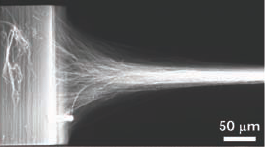Literature on Carbon Nanotube Research: Difference between revisions
No edit summary |
|||
| Line 37: | Line 37: | ||
[[Image:CNTspinning.png]] | [[Image:CNTspinning.png]] | ||
==K. Koziol et al., Science, '''318''', 1892, 2007.== | ==[http://www.sciencemag.org/cgi/content/abstract/sci;318/5858/1892?maxtoshow=&HITS=10&hits=10&RESULTFORMAT=&andorexacttitleabs=and&andorexactfulltext=and&searchid=1&FIRSTINDEX=0&volume=318&firstpage=1892&resourcetype=HWCIT K. Koziol et al., Science, '''318''', 1892, 2007.]== | ||
The paper "High-Performance Carbon Nanotube Fiber" by K. Koziol et al. is a research paper on the production of macroscopic fibers out of an aerogel (low-density, porous, solid material) of SWNT and MWNT that has been formed by carbon vapor deposition. They present an analysis of the mechanical performance figures (tensile strength and stiffness) of their samples. The samples are fibers of 1, 2, and 20mm length and have been extracted from the aerogel with high winding rates (20 metres per minute). Indeed higher winding rates appear to be desirable, but the authors have not been able to achieve higher values as the limit of extraction speed from the aerogel was reached, and higher speeds led to breakage of the aerogel. | The paper "High-Performance Carbon Nanotube Fiber" by K. Koziol et al. is a research paper on the production of macroscopic fibers out of an aerogel (low-density, porous, solid material) of SWNT and MWNT that has been formed by carbon vapor deposition. They present an analysis of the mechanical performance figures (tensile strength and stiffness) of their samples. The samples are fibers of 1, 2, and 20mm length and have been extracted from the aerogel with high winding rates (20 metres per minute). Indeed higher winding rates appear to be desirable, but the authors have not been able to achieve higher values as the limit of extraction speed from the aerogel was reached, and higher speeds led to breakage of the aerogel. | ||
Revision as of 20:44, 13 March 2009
| Title: CNT Literature | ||
|
[Cover Img] |
About:
|
Tags:
|
Literature Review
I have hijacked this page to write down my views on the literature on Carbon Nanotube (CNT) growths and processing, a procedure that should give us the cable/ribbon we desire for the space elevator. I will try to put as much information as possible here. If anyone has something to add, please do not hesitate!
K. Koziol et al., Science, 318, 1892, 2007.
The paper "High-Performance Carbon Nanotube Fiber" by K. Koziol et al. is a research paper on the production of macroscopic fibers out of an aerogel (low-density, porous, solid material) of SWNT and MWNT that has been formed by carbon vapor deposition. They present an analysis of the mechanical performance figures (tensile strength and stiffness) of their samples. The samples are fibers of 1, 2, and 20mm length and have been extracted from the aerogel with high winding rates (20 metres per minute). Indeed higher winding rates appear to be desirable, but the authors have not been able to achieve higher values as the limit of extraction speed from the aerogel was reached, and higher speeds led to breakage of the aerogel.
They show in their results plot (Figure 3A) that typically the fibers split in two performance classes: low-performance fibers with a few GPa and high-performance fibers with around 6.5 GPa. It should be noted that all tensile strengths are given in the paper as GPa/SG, where SG is the specific gravity, which is the density of the material divided by the density of water. Normally SG was around 1 for most samples discussed in the paper. The two performance classes have been interpreted by the authors as the typical result of the process of producing high-strength fibers: since fibers break at the weakest point, you will find some fibers in the sample, which have no weak point, and some, which have one or more, provided the length of the fibers is in the order of the frequency of occurrence of weak points. This can be seen by the fact that for the 20mm fibers there are no high-performance fibers left, as the likelihood to encounter a weak point on a 20mm long fiber is 20 times higher than encountering one on a 1mm long fiber.
As a conclusion the paper is bad news for the SE, since the difficulty of producing a flawless composite with a length of 100,000km and a tensile strength of better than 3GPa using the proposed method is enormous. This comes back to the ribbon design proposed on the Wiki: using just cm-long fibers and interconnect them with load-bearing structures (perhaps also CNT threads). Now we have shifted the problem from finding a strong enough material to finding a process that produces the required interwoven ribbon. In my opinion the race to come up with a fiber of better than Kevlar is still open.
